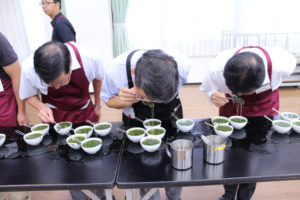Professional tea tasters in Japan have their own way to evaluate teas.
One of the main goals is to identify flaws, because unrefined teas are evaluated by the wholesalers that refine them.
As a consumer, you don’t really need to evaluate teas this way because they won’t be prepared in the same manner that you do at home.
Long infusion times with boiling water are used, so the green teas will feel much stronger.
I’ll specify the guidelines for sencha, but keep in mind that a fukamushi sencha or other types of green tea are judged differently.
Leaf shape
First of all, one must be in a room that has lighting of more than 600 lux.
In order to visually inspect the tea, 100 to 150 grams of tea leaves are placed in the standard black tray.
The size of the leaf, how tightly it’s rolled, the shape, uniformity, and finally the existence of small buds, tea dust, stems and twigs are taken into account.
Ideally, a sencha should have tightly rolled leaves in the shape of a needle. The leaves should be uniform and there shouldn’t be much broken leaves, tea dust, stems, twigs, and buds that are rolled into small balls.
Another part of this inspection is done with one’s hands.
Sencha leaves of high quality should feel relatively heavy and smooth.
Leaf color
Now we can concentrate on the color, which is described with concepts like chroma, hue, and brightness.
For a sencha we want a deep green color with luster.
Red or black hue, pale tea leaves, and no luster indicate low quality.
Liquour color
Before the evaluation, the tea must be prepared in a standard way depending on its type.
Boiling water is poured over 3 grams of tea leaves inside a standard white teacup that holds 200 ml of water.
The time of the infusion depends on the type of tea. For example, 5 minutes for sencha, 4 minutes for fukamushi sencha, and 6 minutes for gyokuro.
The spent tea leaves are removed with a netted spoon so that one can better judge the color of the liquor.
The tone, strength, clarity or murkiness, and amount of sediment are evaluated.
A bright yellow-green is desirable for sencha.
Red or black hue, murky, and with too much sediment are signs of a low quality sencha liquor.
Aroma
The wet tea leaves are smelled by picking them up with a netted spoon from the teacup and taking them near one’s nose.
This is done both when the tea leaves are hot, and when they have cooled down, since some aromas are easier to detect at lower temperatures.
Green tea aroma is said to be a combination of floral, fruity, and resin aroma.
For sencha, we want a fresh aroma of young buds, and some sweetness.
The overall aroma must be balanced.
These aromas are undesirable: hard or old leaves, excessively vegetal, bruised leaves, burnt leaves, smoke, oil, damp, foreign matter, wilted, etc.
Taste
To evaluate taste, the tea is prepared in the standard way, and then with a spoon 5 ml of the liquid is drank. Normally it is done after examining the liquor color.
If there are many teas to be evaluated, then the liquid is spat out after tasting it.
The main things to look for are sweetness, astringency, bitterness and umami taste.
For sencha, a balance of the main tastes is desirable. Also, there should be a fresh aftertaste.
Excessive bitterness and astringency, a taste of bruised leaves, faint taste, burnt leaf taste, taste of old and hard leaves, damp taste, and a foreign taste are undesirable.
Grading system
The procedure requires the subtraction of points for each aspect. There are 200 points in total.
However, each type of tea has different weights per main aspect.
For example, gyokuro has more points placed in its leaf shape and color than sencha.
Another thing to know is that matcha isn’t evaluated directly.
Tencha is used instead, which is the raw material of matcha.
As you can imagine, successful tea evaluation requires much more practice than theory.
It is very hard to learn this properly without being taught physically and evaluating teas regularly.

